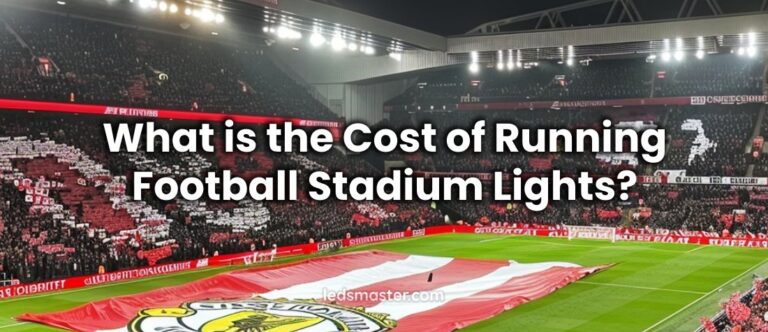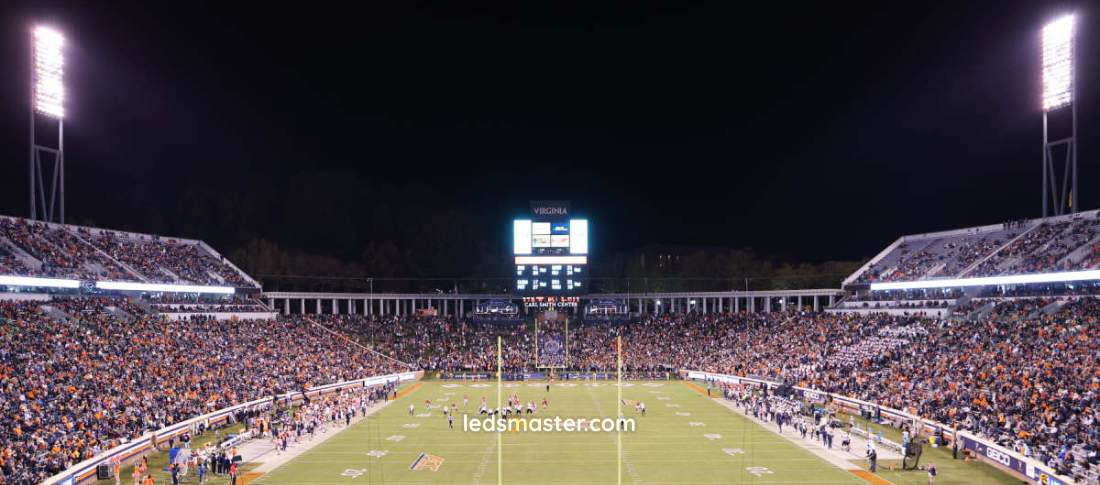
Understanding the costs associated with football field lighting is essential for making informed decisions. This overview breaks down the various expenses involved, from initial setup and operational costs to long-term benefits of investing in modern lighting solutions like LED technology.
Get your complimentary lighting design today
When it comes to illuminating a football field, understanding the associated costs is essential for sports organizations, schools, and municipalities. Effective lighting not only enhances visibility for players and spectators but also ensures safety and compliance with regulatory standards. This article delves into the various costs involved in football field lighting, including initial setup costs, labor costs, operational expenses, maintenance costs, and the long-term benefits, with a particular focus on LED lighting technology.
Table of Contents
ToggleThe initial setup cost for football field lighting encompasses several key elements, including the purchase of lighting fixtures, poles, electrical systems, and installation labor. Each of these components plays a crucial role in ensuring that the field is adequately illuminated for both players and spectators. The choice of lighting technology significantly influences these costs. Traditional lighting systems, such as high-intensity discharge (HID) lamps, may seem less expensive upfront due to lower initial fixture prices. However, they often require a higher number of fixtures and greater wattage to achieve sufficient illumination levels across the field. This can lead to increased costs over time, as more fixtures necessitate additional electrical infrastructure and higher energy consumption.
In contrast, LED lighting has become increasingly popular due to its efficiency and long-term cost benefits. Although the initial investment in LED fixtures may be higher, they typically require fewer fixtures to produce the same, or even superior, lighting quality. This reduced need for fixtures not only lowers the initial setup cost but also simplifies the installation process, making LED systems an attractive option for football field lighting.
When planning the installation of lighting for a football field, it is essential to consider the field’s dimensions and layout carefully. A standard football field generally requires between 30 to 40 poles, each equipped with multiple fixtures, to ensure uniform lighting coverage across the entire area. Proper placement of these poles is critical to avoid dark spots and ensure that all areas of the field are well-lit, enhancing player safety and visibility during games.
Moreover, the orientation of the poles and the angle of the fixtures must be planned to minimize glare for both players and spectators. This detailed planning can influence the overall installation cost, as more intricate designs may require additional labor and materials. While the upfront costs for LED systems may appear higher due to the premium price of LED fixtures, these expenses are often offset by significantly lower operational costs and longer lifespans, making them a wise investment in the long run.
Labor costs are a significant component of the overall lighting project budget. These costs encompass the expenses associated with hiring electricians, installation crews, and any required contractors to complete the installation. Labor costs can vary depending on the region, the complexity of the installation, and the expertise of the professionals involved. For instance, installing a new LED lighting system may require specialized knowledge to ensure proper placement and functionality, leading to potentially higher labor rates.
Furthermore, if the project involves extensive electrical work or structural modifications to accommodate the lighting, additional labor costs may arise. It is crucial to account for these costs in the initial budgeting phase to avoid unexpected financial burdens later on.

Operational costs refer to the ongoing expenses related to the daily use of the lighting system for a football field. These costs are a crucial factor in the overall budgeting process, as they directly impact the long-term financial sustainability of the lighting investment. Key components of operational costs include electricity consumption, labor for operating the lighting system, and any auxiliary systems that may be implemented to enhance efficiency.
Electricity consumption is one of the primary operational costs associated with football field lighting. This cost can vary significantly based on the type of lighting technology used. Traditional lighting solutions, such as high-intensity discharge (HID) lamps, are known for their high energy consumption. HID lamps typically use between 1,500 to 2,000 watts, making them expensive to operate over time. In contrast, LED lighting systems have gained popularity for their energy efficiency. Equivalent LED fixtures can operate at only 500 to 800 watts while delivering similar brightness levels, resulting in substantial savings on energy bills.
The difference in energy consumption not only affects operational costs but also influences the environmental impact of the lighting system. By choosing LED technology, organizations can significantly reduce their carbon footprint, aligning with sustainability goals and practices.
In addition to electricity costs, operational expenses can include costs associated with timers, controllers, and any smart lighting technologies implemented. These systems are designed to optimize lighting use, ensuring that lights are only on when necessary. For instance, smart controllers can automatically adjust lighting based on real-time conditions, such as the time of day or the presence of players and spectators. This capability further reduces energy consumption and costs, making the lighting system more efficient.
Investing in these auxiliary systems may incur additional upfront costs; however, the long-term savings from reduced energy consumption and enhanced efficiency often justify this initial investment. Smart lighting solutions not only improve operational efficiency but also contribute to a better overall user experience by providing adequate lighting tailored to specific needs.
The cumulative effect of electricity consumption, labor costs, and auxiliary systems can significantly impact the overall budget for football field lighting. While the initial setup costs may be substantial, understanding the ongoing operational costs is essential for making informed financial decisions. By opting for energy-efficient solutions like LED lighting and integrating smart technologies, organizations can create a more manageable and sustainable budget for their lighting needs.
Maintenance costs are another critical aspect of football field lighting expenditures. Over time, all lighting systems require upkeep to ensure optimal performance and safety. Traditional lighting sources, such as metal halide and high-pressure sodium lamps, typically have shorter lifespans and require more frequent bulb replacements. This results in increased maintenance labor and parts costs.
On the other hand, LED lights boast significantly longer lifespans, often exceeding 50,000 hours of use. This longevity translates into reduced maintenance costs, as fewer replacements are needed over time. Additionally, LEDs are more durable and resistant to environmental factors, leading to lower overall maintenance demands. Organizations can save both time and money by investing in LED technology for their football field lighting.
| Item | Description | Price Range (USD) |
|---|---|---|
| LED Lighting Fixtures | Energy-efficient fixtures providing optimal brightness | $200 – $600 per fixture |
| HID Lighting Fixtures | Traditional fixtures requiring more power and maintenance | $100 – $400 per fixture |
| Lighting Poles | Poles for mounting fixtures, varies by height and material | $1,000 – $3,000 each |
| Electrical Systems | Wiring, circuit breakers, and panels for installation | $2,000 – $10,000 total |
| Installation Labor | Professional installation services | $5,000 – $15,000 total |
| Timers/Controllers | Systems for automating lighting use | $500 – $1,500 each |
| Maintenance Supplies | Bulbs, fixtures, and equipment for ongoing maintenance | $300 – $1,000 annually |
| Smart Lighting Technology | Advanced systems for energy optimization | $1,000 – $5,000 total |
Investing in LED lighting for football fields comes with numerous long-term benefits that extend beyond immediate cost considerations. One of the most significant advantages is energy efficiency. LED lights consume considerably less power compared to traditional lighting options, translating into substantial savings on energy bills. Organizations can often expect a return on investment (ROI) within just a few years due to the reduced operational costs associated with LED technology. This energy efficiency not only lowers monthly expenses but also contributes to budget stability over time.
Moreover, the environmental impact of choosing LED lighting is noteworthy. By consuming less energy, organizations can significantly reduce their carbon footprint, contributing to sustainability goals and promoting environmental stewardship. Many municipalities and institutions are increasingly prioritizing green initiatives, making LED lighting a more attractive option for funding and community support. By adopting LED technology, organizations can align with these initiatives, enhancing their reputation as environmentally conscious entities.
Additionally, improved lighting quality enhances player safety and performance. Well-lit fields minimize shadows and dark spots, allowing athletes to see the ball and their surroundings more clearly. This increased visibility can reduce the risk of injuries, fostering a safer playing environment. Moreover, optimal lighting conditions can enhance the overall game experience for players and spectators alike, leading to more engaging and enjoyable events.
Another important long-term benefit of LED lighting is the reduced maintenance costs. LED fixtures have longer lifespans, often exceeding 50,000 hours, which means fewer replacements and less frequent maintenance. This longevity leads to significant savings in labor costs associated with changing bulbs and performing routine checks. By minimizing maintenance needs, organizations can allocate resources more effectively, allowing for investment in other critical areas.
Finally, investing in quality lighting not only benefits the immediate organization but also contributes positively to the community and local economy. Well-lit fields can increase usage and hosting opportunities for local events, tournaments, and practices, thereby generating additional revenue. Communities often see improved engagement and participation in sports activities, which can have lasting positive effects on community health and cohesion.
Understanding the costs associated with football field lighting is crucial for making informed decisions, as initial setup costs, labor expenses, operational costs, and maintenance considerations all play a significant role. However, the long-term benefits of investing in LED lighting are substantial, offering energy savings, lower maintenance demands, improved safety, and environmental advantages. As organizations increasingly prioritize sustainability and cost-effectiveness in sports facility management, the shift towards LED lighting is likely to gain momentum. By making informed choices today, sports organizations can ensure their facilities remain well-lit, safe, and financially sustainable for years to come.